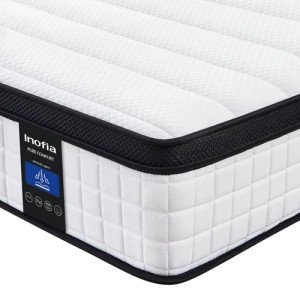The Comprehensive Guide to Latex Memory Foam Mattresses
On the planet of sleep technology, latex memory foam mattresses have become a popular choice among consumers seeking convenience and support. Mixing the advantages of latex and memory foam, these mattresses provide a special sleeping experience that deals with numerous sleep choices. This short article supplies an extensive take a look at latex memory foam mattresses, exploring their features, benefits, and factors to consider, along with a relative analysis with standard mattresses.
What is a Latex Memory Foam Mattress?
Latex memory foam mattresses integrate two unique kinds of products: natural or synthetic latex and memory foam. Each contributes distinct characteristics that improve sleep quality.
- Latex deals elasticity and responsiveness, providing bounce while contouring to the sleeper's body.
- Memory foam is known for its pressure-relieving homes and capability to adjust to body shape.
Structure of a Latex Memory Foam Mattress
Normally, a latex memory foam mattress includes several layers:
- Top Layer: Soft memory foam that complies with the body.
- Middle Layer: Supportive latex that supplies bounce and air flow.
- Base Layer: High-density foam or latex that uses resilience and stability.
This mix results in a mattress that adheres while maintaining structural integrity, making it a viable alternative for different sleeping positions.
Benefits of Latex Memory Foam Mattresses
Latex memory foam mattresses have garnered attention for various benefits, making them an appealing choice for consumers. Here are some advantages:
- Pressure Relief: The memory foam component distributes weight equally, minimizing pressure points, especially for side sleepers.
- Support: The latex layer offers excellent spinal support, promoting healthy posture throughout sleep.
- Durability: Latex is naturally durable and can withstand drooping, causing a longer life expectancy compared to standard mattresses.
- Temperature level Regulation: Latex is breathable, assisting to dissipate heat and control sleep temperature level, countering the heat retention typically discovered in standard memory foam.
- Hypoallergenic Properties: Many latex materials are resistant to allergen, mold, and other irritants, making this option suitable for allergic reaction patients.
Table: Comparison of Mattress Types
| Function | Latex Memory Foam Mattress | Innerspring Mattress | Standard Memory Foam Mattress |
|---|---|---|---|
| Pressure Relief | High | Moderate | High |
| Support | Excellent | Variable | Good |
| Resilience | High | Moderate | Moderate |
| Temperature level Regulation | Great | Moderate | Low |
| Motion Isolation | Excellent | Low | High |
| Hypoallergenic | Yes | No | No |
| Cost | Moderate to High | Low to Moderate | Moderate |
Factors to consider Before Purchase
While latex memory foam mattresses provide numerous advantages, possible buyers ought to consider numerous factors before buying:
- Cost: These mattresses can be more pricey than conventional alternatives. browse around this web-site is necessary.
- Weight: Latex mattresses tend to be heavy, making them more challenging to move. Consider delivery and setup alternatives.
- Feel: Some sleepers might discover the combination of latex and memory foam uncommon. Testing the mattress in-store when possible is advised.
- Firmness Level: Firmness preference varies by individual. It's important to pick a mattress that aligns with individual comfort.
Tips for Choosing the Right Latex Memory Foam Mattress
- Test Different Brands: Not all latex memory foam mattresses are developed equivalent. Try numerous to discover the ideal fit.
- Try to find Certifications: Certifications like Oeko-Tex Standard 100 or Green Guard Gold can show eco-friendly materials and manufacturing procedures.
- Check Warranty and Trial Periods: A great warranty and trial period enable users to check the mattress without long-lasting commitment.
- Review the Return Policy: Ensure that the return policy is sensible in case the mattress does not satisfy expectations.
Frequently Asked Questions (FAQs)
1. How long does a latex memory foam mattress last?
Latex memory foam mattresses can last anywhere from 10 to 20 years, depending upon the quality of products and use.
2. Is a latex memory foam mattress appropriate for all sleeping positions?
Yes, these mattresses use appropriate assistance and pressure relief for numerous sleeping positions, consisting of back, side, and stomach sleepers.
3. Do latex memory foam mattresses produce off-gassing?
While artificial memory foam can discharge off-gassing smells, high-quality latex options (especially natural latex) generally have minimal odor when unboxed.
4. How do I clean and preserve my latex memory foam mattress?
Routinely vacuuming the surface, using a protective cover, and area cleansing spots with moderate cleaning agent can assist maintain tidiness and durability.
5. Can I use a latex memory foam mattress on any bed frame?
A lot of latex memory foam mattresses can be utilized on numerous bed frames, however slatted structures must have fairly close slats (usually no more than 3 inches apart) to avoid drooping.
Latex memory foam mattresses mix the relaxing qualities of memory foam with the supportive features of latex, making them a notable choice in the market. With different benefits like pressure relief, durability, and hypoallergenic residential or commercial properties, they cater to a varied variety of sleepers. Prospective buyers must consider specific preferences, weight, costs, and maintenance requirements when purchasing. By doing so, they can ensure a sleeping experience that is both comfortable and rejuvenating, ultimately causing better rest and overall wellness.

